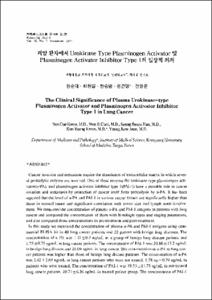폐암 환자에서 Urokinase Type Plasminogen Activator 및 Plasminogen Activator Inhibitor Type 1의 임상적 의의
- Keimyung Author(s)
- Choi, Won Il; Han, Sung Beom; Jeon, Young June; Kwon, Kun Young
- Department
- Dept. of Internal Medicine (내과학)
Dept. of Pathology (병리학)
Institute for Medical Science (의과학연구소)
- Journal Title
- Keimyung Medical Journal
- Issued Date
- 2000
- Volume
- 19
- Issue
- 2
- Keyword
- U-PA; PAI-1; Lung cancer
- Abstract
- Cancer invasion and metastasis require the dissolution of extracellular matrix in which several proteolytic enzyme are involved. One of these enzyme the urokinase-type plasminogen activator(u-PA), and plasminogen activator inhibitor type 1(PAI-1) have a possible role in cancer invasion and metastasis by protection of cancer itself from proteolysis by u-PA. It has been reported that the level of u-PA and PAI-1 in various cancer tissues are significantly higher than those in normal tissue and significant correlation with tumor size and lymph node involvement. We measured the concentration of plasma u-PA and PAI-1 antigens in patients with lung cancer and compared the concentration of them with histologic types and staging parameters, and also compared those concentrations in pre-treatment and post-treatment.
In this study we measured the concentration of plasma u-PA and PAI-1 antigens using commercial ELISA kit in 40 lung cancer patients and 22 patient with benign lung diseases. The concentration of u-PA was 1.37±0.7 ng/mL in a group of benign lung disease patients and 1.75±0.75 ng/mL in lung cancer patients. The concentration of PAI-1 was 20.86±13.2 ng/mL in benign lung disease and 20.09 ng/mL in lung cancer. The concentration of u-PA in lung cancer patients was higher than those of benign lung disease patients. The concentration of u-PA was 2.42±2.69 ng/mL in lung cancer patients who were not treated, 1.78 ng±0,79 ng/mL in patients who were treated. The concentration of PAI-1 was 19.53±11.75 ng/mL in not-treated lung cancer patients, 10.71±6.26 ng/mL in treated patient group. The concentration of PAI-1 in treated lung cancer patients was lower than those of not-treated lung cancer patients. The concentration of u-PA was 1.82 ng/mL in stage I & Ⅱ, 1.93±0.11 ng/mL in stage Ⅲ, 1.65±0.17 ng/mL in stage Ⅳ. The concentration of PAI-1 was 15.92±5.57 ng/mL in stage I & Ⅱ, 20.95±0.54 ng/mL in stage Ⅲ, 23.99±2.5 ng/mL in stage Ⅳ. The concentration of u-PA was 1.28±0.45 ng/mL in small cell carcinoma, 1.86±0.12 ng/mL in nonsmall cell carcinoma 1.76±0.0 ng/mL in squamous cell carcinoma 1.93±0.2 ng/mL in adenocarcinoma. The concentration of PAI-1 was 18.74±3.83 ng/mL in small cell carcinoma 23.13±3.95 ng/mL in nonsmall cell carcinoma 25.39±2.81 ng/mL in squamous cell carcinoma 20.96±1.62 ng/mL in adenocarcinoma.
The plasma levels of u-PA in lung cancer patients were higher than those benign lung disease and plasma level of PAI- 1 in who were treated (surgery, chemotherapy and/or radiotherapy) were lower than those who were not treated. These findings suggest involvement of U-PA with local invasion of lung cancer and possible roles in predicting the prognosis and survival of lung cancer patients.
- Alternative Title
- The Clinical
Significance of Plasma Urokinase-type Plasminogen Activator and Plasminogen Activator Inhibitor
Type 1 in Lung Cancer
- Publisher
- Keimyung University School of Medicine
- Citation
- 권순대 et al. (2000). 폐암 환자에서 Urokinase Type Plasminogen Activator 및 Plasminogen Activator Inhibitor Type 1의 임상적 의의. Keimyung Medical Journal, 19(2), 215–224.
- Type
- Article
- 파일 목록
-
-
Download
 19-215.pdf
기타 데이터 / 888.87 kB / Adobe PDF
19-215.pdf
기타 데이터 / 888.87 kB / Adobe PDF
-
Items in Repository are protected by copyright, with all rights reserved, unless otherwise indicated.